YELLOWSTONE (Day 4 - part 1)
Pieces of ice coated my tent in the morning. Today I was going to follow the geyser route.
My first stop was the Norris Geyser area. This was a large area, basically divided into two sections: the Porcelain Basin (1/2 mile loop) and the Back Basin (1 1/2 mile loop).
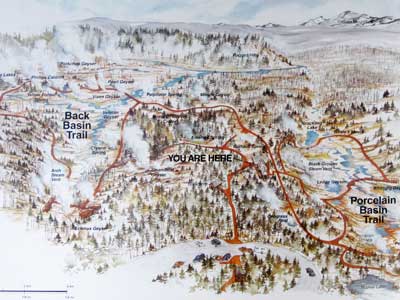
Map of the Norris Geyser area (click for a larger view)
The basin sits on the edge of a huge caldera. The Yellowstone Volcano, one of the largest on earth, erupted around 640,000 years ago. This ripped open miles of terrain, leaving behind a massive caldera that stretches 45 miles from rim to rim. Later, flowing lava obscured the crater edges, partially filling it in and reshaping the landscape. The last lava flow occurred about 70,000 years ago.

The Yellowstone caldera
Water flows down from the peaks of the Gallatin Mountains and accumulates underground, where it is heated by the Yellowstone Volcano. The hot water travels up to the surface in the form of acidic geysers, steaming fumaroles and simmering pools.

How geothermal features work (click for a larger view)
FUMEROLES or steam vents are hot springs without enough water to erupt or flow. The water quickly boils away, leaving only steam and gas.
HOT SPRINGS are pools of heated water, ranging from luke warm to boiling. Water circulation is continuous, with the cooler surface water sinking and the lower hotter water rising.
MUD POTS are pools of scalding water lying over steam vents. Gasses interact with the surface water and organic matter to create acid, which breaks down rock into clay.
GEYSERS are hot springs that periodically erupt. There are two basic categories: cone geysers (such as Old Faithful, with a narrow opening that spouts a steady stream of water. Over time, sinter or silica builds up around the vent opening creating a cone) and fountain geysers (have wide openings and are often mistaken for hot springs).

Yup, these things are hot and people have actually died doing stuff like this.
I started with the Porcelain Basin loop trail, so named because of the milky mineral deposited here known as siliceous sinter (also known as geyserite). This is the fastest changing area in the basin. While the deposits accumulate very slowly (less than an inch per century), the mineral can potentially seal off a hot spring or geyser, causing the hot pressurized water to flow elsewhere until it finds a spot weak enough to burst through.
It was so early that I was entirely alone. The only sounds were of a hissing, bubbling and gurgling earth.


Steam poured from the ground... and blocked out the sun.


Wooden walkways kept me safe from the boiling ground.


A steam vent ... and the Colloidal Pool




The walkway ... and Whirligig Geyser


Thermophiles are microorganisms that thrive in heat. Here, they must survive a highly acidic environment as well.
Thermophiles are too small to see without a microscope. The number of thermophiles living in a 10-square inch can exceed the number of people living on earth. Some live in hotter areas (red colors, 122-140 degrees F) while others reside in cooler areas (green colors, 100 - 133 degrees F). The red ones are called chemotrophs and get their energy from the iron in the water. Their color comes from being coated in rust. The green ones are thermophilic algae, getting their energy from the sun via photosynthesis.




The steam and dead trees almost looked like a forest fire!




Crackling Lake
I then followed the Back Basin trail, which wandered through a more forested area.

Again, it looked as if a forest fire raged.
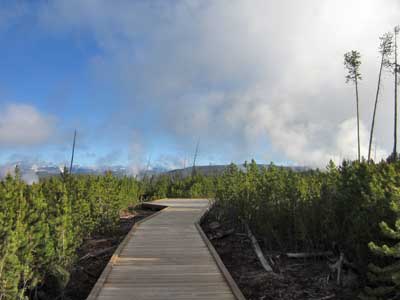


Steamboat Geyser


Cistern Spring was filled with different colors of algae and bacteria... each living in the temperature that was right for them.

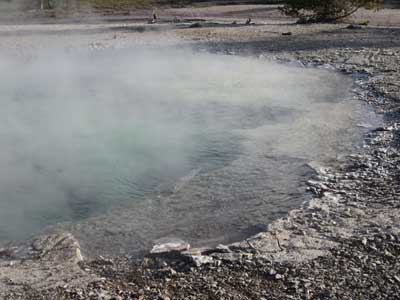
Crater Spring


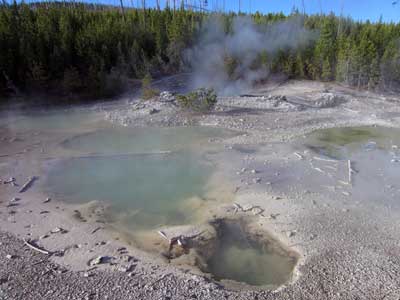

Bubbles rise up from some deep pools.


In the midst of all this heat and acidity, life (such as these flowers and this plover) still finds a way to thrive.

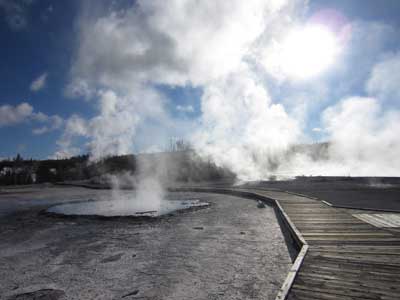
The boardwalk continues on... past Pearl Geyser.


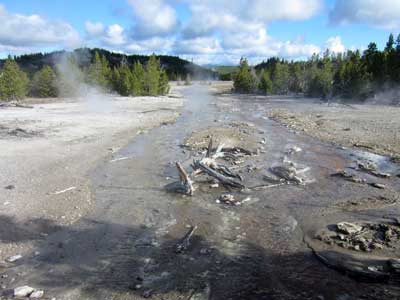

A steaming river ... and Veteran Geyser



Minute Geyser used to erupt every 60 seconds, with spouts reaching up to 50 feet. Unfortunately the park's main road once ran right by here, and tourists felt the need to toss rocks into it as a sort of wishing well. This clogged its vent so that its eruptions are now small and irregular.
return • continue